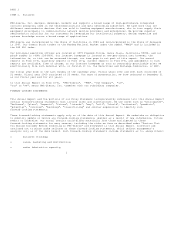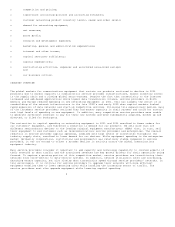Adaptec 2002 Annual Report Download - page 4
Download and view the complete annual report
Please find page 4 of the 2002 Adaptec annual report below. You can navigate through the pages in the report by either clicking on the pages listed below, or by using the keyword search tool below to find specific information within the annual report.In simple terms, the Internet is a hybrid series of networks comprised of copper wires, coaxial cables, and
fiber optic cables. These networks carry high−speed traffic in the form of electrical and optical signals
that are transmitted and received by complex networking equipment. To ensure this equipment and the various
networks can easily communicate with each other, the OEMs and makers of communications semiconductors have
developed numerous communications standards and protocols for the industry. These communications protocols
make it easier for complex high−speed data traffic to be sent and received reliably and efficiently − −
whether intra−office, across the country, or internationally.
One industry standard that packages information into a fixed−size cell format for transportation across
networks is ATM or Asynchronous Transfer Mode. Many service providers deploy equipment that handles this
protocol because it can support voice, video, data, and multimedia applications simultaneously.
Another established industry standard is called SONET or Synchronous Optical Network for high capacity data
communication over fiber optic systems. This is used in the Americas and parts of Asia, with the equivalent
standard in the rest of the world called SDH or Synchronous Digital Hierarchy.
In addition to using SONET to increase the bandwidth, or capacity of, in their networks, many system
operators have also deployed equipment that uses a technology called dense wave division multiplexing.
Rather than transmitting a single light signal over an optical fiber, dense wave division multiplexing
allows many different light signals (each of a different wavelength) to be transmitted simultaneously. By
deploying this technique at higher transmission rates, carriers can move more signals across transmission
lines.
IP is a transport protocol that maintains network information and routes packets across networks. While IP
packets are larger and can hold more data than ATM cells, service providers often have difficulty providing
the same quality of service with IP because it is not optimized for time−sensitive signals such as video and
voice services.
Ethernet is another protocol that is used extensively in data transmission in local area networks (LAN) and
is now being used in wide area networks (WAN) as well. Service providers are beginning to deploy ethernet
because they are familiar with the protocol and it is a relatively efficient way to handle increasing
amounts of data moving from the LAN to the WAN.
In some service provider networks, a traffic bottleneck can occur where the high−speed long−haul traffic is
handed off to networking equipment in the metro area or where storage networks are being inter−connected. In
general, service providers have invested less to enhance the infrastructure in these areas and as a result,
many of these systems have insufficient capacity to handle the increasing level of data traffic.
In response, many OEMs are designing faster and more complex equipment to handle the higher volumes in the
network. This equipment must be able to accommodate various protocols and formats, including cell−based ATM
and packet−based Internet Protocol (IP).
To accommodate these different protocols and the growing demand for services, many service providers are
requiring OEMs to provide more complex, integrated solutions in a shorter time period. At the same time,
some of the OEMs have undergone significant corporate restructurings and have fewer resources and technical
staff internally to design their own custom solutions. This, coupled with the rising cost of custom
semiconductors, has resulted in the OEMs outsourcing more of their communications integrated circuit
requirements to companies such as PMC−Sierra. This has brought about the acceleration of the use of standard
products of the kind that PMC−Sierra designs and develops.
4

















